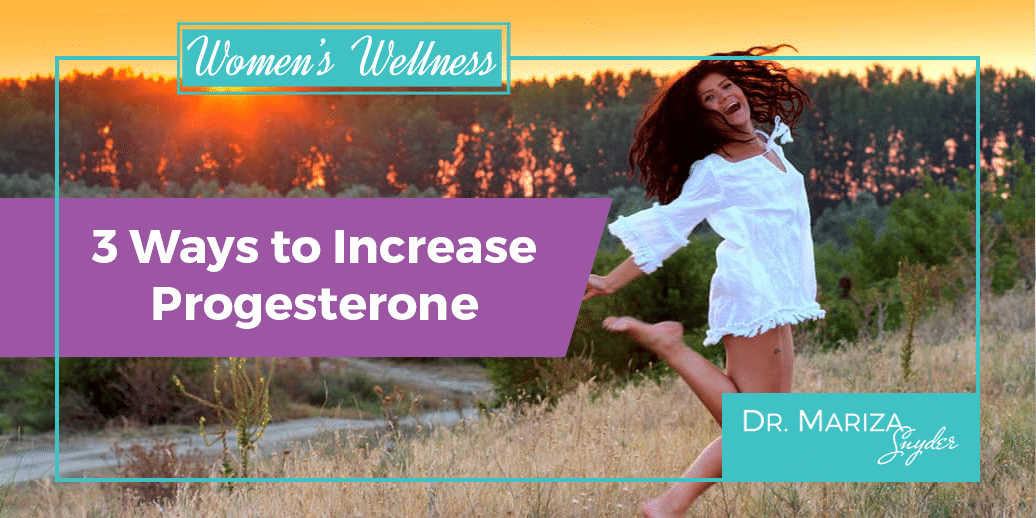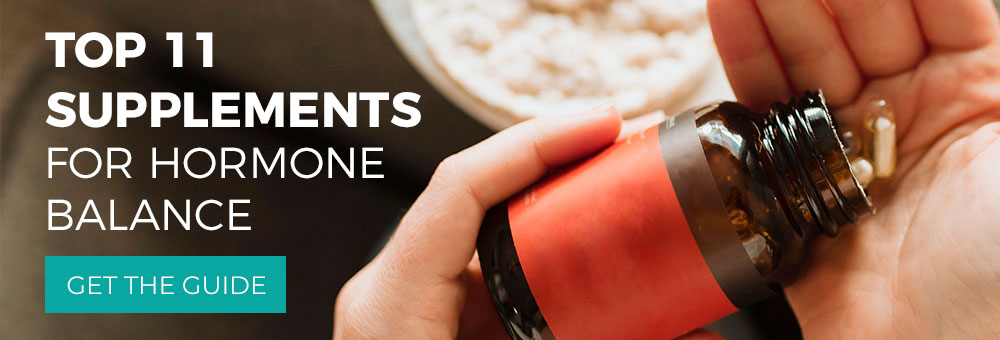
When your body is experiencing hormonal imbalance, it can be very easy to feel like your entire life is out of balance. One critical part of feeling (and looking!) your best, is to make sure that your hormone levels are in agreement with one another for the stage of life that you are in.
Women who are between the ages of 35 and 50 years old are at particular risk for hormone imbalance as they approach the season of perimenopause and menopause. If you find yourself with symptoms that your body isn’t functioning at its best, low levels of progesterone may be to blame. Learning as much as you can about progesterone might be just the key that you need to get your body back into balance in a healthy, natural manner.
WHAT IS PROGESTERONE?
While most women know that progesterone is one of the progestogen steroid female hormones, not everyone is exactly sure what this hormone does or why it is important. The production of progesterone is triggered by the pituitary gland through the corpus luteum, while smaller amounts may also be produced by the ovaries and the adrenal glands.
Because fluctuations in progesterone levels are linked to triggering the onset of the menstrual cycle, women who have low levels of this hormone may find themselves with irregular periods. Other women may possibly find that they are unable to get pregnant, or even that they are not able to carry a pregnancy to term due to miscarriage.
But even for women who are not necessarily in the throes of child-bearing, low levels of progesterone may cause an increase in levels of estrogen as the body tries to compensate by producing more estrogen. And too-high estrogen levels (called Estrogen Dominance) can tend to wreak all kinds of havoc on a woman’s body including problems with weight gain, very heavy menstrual flow, decreased libido, migraine headaches, gallbladder illness, mood changes, hot flashes, and other issues. These may even be related to severe issues such as Polycystic Ovarian Syndrome (PCOS).
SIGNS OF LOW PROGESTERONE LEVELS
While some women are fortunate enough to have balanced hormones, many women struggle at various times in their lives. Of course, a critical part of diagnosing low levels of progesterone is asking a medical professional to perform a simple saliva, or blood test. I always recommend knowing your numbers and testing should be done by any woman who is suspicious that her hormone levels are out of balance.
However, our bodies are very good at showing us when something is wrong, and we should learn to pay attention to these symptoms rather than ignoring them. Here are some signs that your progesterone levels might be low:
- Insomnia and trouble sleeping
- Hot flashes or night sweats
- PMS, PMDD, and heavy or irregular periods
- Low mood, anxiety, and depression
- Drastic mood swings or irritability
- Weight gain, bloating, and excess fluid
- Brain fog and migraines that occur right before your period
- Decreased libido
- Overall inflammation and pain
HOW TO INCREASE PROGESTERONE LEVELS NATURALLY
Although sometimes hormone intervention from a doctor may be recommended in order to help to increase progesterone, particularly when you are trying to have a baby, at other times you may be able to balance out your body’s levels more naturally. Here are four different natural substances which influence the body’s production of progesterone.
1. Lower Stress
Our busy, stressful lives have a tendency to produce the fight-or-flight response more often than many of our bodies can handle. This response to stress causes the adrenal glands to produce adrenaline and cortisol, and cortisol is created by the use of progesterone. This means that the body of a woman who is regularly stressed (and who isn’t?) will “steal” progesterone in order to produce the cortisol. De-stressing can help to minimize the body’s responses to stress and reduce the tendency to deplete the levels of progesterone.
In addition to robbing progesterone, the stress response also reduces the amount of magnesium in the body, which is an extremely important mineral that helps with the production of progesterone. (See Below.)
Through a regular exercise routine, meditation, yoga, and simple breathing exercises, you can put yourself in a position to reduce your stress and allow your body to focus on producing the progesterone it needs without robbing it to battle stress. Sometimes the reduction of stress may mean reducing the number of hours at work, taking a vacation, avoiding negative people, or seeing a counselor. Do what you need to minimize the effects that you allow stress to have on your mind and body. I also recommend using essential oils for aiding to reduce stress throughout the day in a matter of minutes. Simply breathing in a calming essential oil can help to reduce stress and tension. Try Lavender, Clary Sage, or Ylang Ylang for those stressful moments.
2. Healthy Adrenals
The adrenal glands that produce cortisol and adrenaline also keep track of the steroid DHEA (dehydroepiandrosterone), which is necessary for the production of progesterone in a woman’s body. When the adrenal glands are fatigued, DHEA levels may be reduced.
In order to keep the adrenal glands healthy, we know that we need to reduce stress and cut back on coffee and alcohol. In addition, it has been discovered that healthy sleep patterns and balanced circadian rhythms are critical to healing the adrenal glands. Do this by trying to go to bed at the same time every night—it is best if you’re in bed and ready to sleep by 10 pm. Sleep at least 8 hours per night but no more than 10 hours per night.
Also, nettle is an herb that may help to increase the health of the adrenal glands which can be made into an infusion tea.
3. Healthy Diet
One of the best, most natural ways to increase the level of progesterone in your body is to take great care with what you eat. Food is a foundation to hormone balance. Although there are no foods that actually contain progesterone, the foods that you eat may work to your benefit by increasing your body’s ability to produce progesterone and by decreasing the amount of estrogen you put in your body.
Organic Foods–Eating organic is one great way to make sure that you are not giving your body an added reason to be thrown off balance. Substances used in the growing processes of non-organic foods may contain pesticides and, even more dangerous, added hormones. When consumed, these hormones act as xenoestrogens which increase your body’s estrogen level and throw off your progesterone balance. Avoiding these potentially harmful chemicals and substances for the long-term may help your body to restore its natural balance. Always read your labels to ensure that you are eating organic food.
Herbs–Many people often think that herbs are simply used for flavoring food, but many of them have also been used for centuries in natural medicinal capacities. Certain herbs can be extremely helpful in naturally encouraging the body to balance out the hormones. Some of the natural herbs that boost the body’s ability to increase progesterone are Turmeric, Thyme, Dill, Oregano, Kenya Oak, Szechuan Lovage, and Chasteberry (Vitex).
High Fiber Foods–Although not directly related to the amount of progesterone your body produces, the amount of fiber that you digest could affect your estrogen levels which, in turn, affects progesterone. The longer the food in your body takes to digest, the more estrogen that your body is likely to absorb from the food. A normal amount of digestion time means that any extra amounts of estrogen will be excreted through the stool. But if your digestive system works too slowly, it is possible for the body to reabsorb estrogen that the body trying to get rid of, adding to the imbalance.
Of course, the best way to make sure that your digestive system is working as smoothly as it should is by eating a diet that is high in fiber and low in fats. Increasing fiber intake speeds up the effectiveness of the digestive system and reduces the risk that estrogen will be reabsorbed, effectively creating more opportunity for the hormones to be balanced. High fiber foods to add to your diet: greens, apples, brussels sprouts and broccoli, beans and raspberries.
If you’re finding that it’s hard to get enough fiber through diet alone, millions of other women are in the same boat. Research estimates that a majority of us get only HALF of the fiber we need each day. The simplest way to bridge this gap is with a natural fiber powder you can add effortlessly to your daily beverages or smoothies. My Essentially Whole® Pure Daily Fiber is all-natural, paleo-friendly, and free of inflammatory ingredients that would cause more damage. It is flavorless, not gritty, and won’t cause gastrointestinal upset like many other fibers! Check it out here >>
Magnesium–Found in dark, leafy greens, fish, nuts and more, Magnesium helps to regulate the pituitary gland which produces progesterone. It is estimated that almost ¾ of Americans are not getting enough of this mineral in their diets. Fourth on the list of top minerals in the body, Magnesium recommendations are at approximately 320 mg per day (450mg for pregnant women). Foods that are particularly high in this mineral include raw spinach, pumpkin seeds, mackerel and other fish, brown rice, and even dark chocolate. The simplest way to make sure you’re getting your daily Magnesium is by supplementing. My Essentially Whole® Magnesium Restore is formulated with the type of magnesium that is scientifically proven to be the most easily absorbed by your body. Get it here >>
Vitamin C–Recommended amounts of vitamin C are 250-500 milligrams per day, but no more than 1000mg per day. Foods that are high in ascorbic acid include yellow peppers, oranges, broccoli, kale, and kiwi. Eating these vegetables and fruits raw is the best way to get the most vitamin C impact as cooking them tends to diminish the vitamins very quickly.
Vitamin B6–Another vitamin that aids your body in maintaining adequate amounts of progesterone is Vitamin B6. This can be found in foods such as walnuts, poultry, bananas, leafy greens (raw spinach), beans, and other foods. Increasing the amount of Vitamin B6 you take in can help the liver do its job in breaking down estrogen, allowing the hormones to re-establish balance.
Zinc–With an important role in the monthly cycle, Zinc is critical in prompting the pituitary gland to release the corpus luteum, which ultimately stimulates the production of progesterone. Foods that are high in zinc include shellfish, chickpeas, pumpkin seeds, watermelon seeds, lean red meats, and the ever-popular dark chocolate.
There are plenty of times in a woman’s life when our bodies seem to go haywire, but finding a balance through lifestyle modification can help you to regain the balance that you lost. Trust me – it did in my life! Changing your diet, incorporating daily exercise and relaxation techniques, and working on developing a daily regimen of hormone-supportive oils into your life can do wonders for your overall emotional and physical well-being.
HOW TO GET IMMEDIATE RELIEF WHEN YOU NEED IT MOST
I know how hard it is to live with the symptoms of progesterone deficiency. You’re going through life barely surviving, so these changes may feel like too much effort.
If you want to take the edge off and get some immediate relief while you address the root causes (or, if you’re in perimenopause, while your body rebalances and adjusts to this transition), your best option is a bioidentical topical natural progesterone serum.
Essentially Whole® Progest-Restore is my own custom designed formula to naturally increase progesterone levels without dangerous synthetic hormones or artificial ingredients.
Applying Progest-Restore throughout the day is a simple way to ease feelings of stress and anxiety, reduce hot flashes, help you sleep better, give your energy a boost, and protect your body from the dangers of excess estrogen.
Get Progest-Restore HERE today!
Naturally Increasing Progesterone FAQ:
How can I increase progesterone naturally?
The best ways to create a healthy level of progesterone in your body are to reduce stress, support healthy adrenal function, and and support your body with essential vitamins, minerals and nutrients such as fiber, magnesium, B vitamins, vitamin C, zinc, and herbs like Turmeric, Thyme, Dill, Chastetree and Oregano.
How do you fix low progesterone?
Stress depletes your body’s progesterone levels, so reducing stress needs to be your first step. Next, support your adrenal health with supplements and nutrition. Finally, make sure you are getting enough fiber, magnesium, B vitamins, vitamin C, and zinc and supporting your body with hormone-healthy herbs.
What are the symptoms of low progesterone?
The biggest indicators of low progesterone include: difficulty getting or staying pregnant, spotting between periods, abdominal pain during pregnancy, short menstrual cycles, feeling cold, having hypothyroidism, extreme PMS, low libido, having low cholesterol and being underweight. People at highest risk of having low progesterone are women age 35-50 who are in perimenopause.
What causes low progesterone?
Low progesterone can impact women of any age, usually started by high stress levels, poor adrenal health, or nutrient deficiencies. However, in women over 35, progesterone levels decrease as your ovaries decline in their ability to produce it.
FREE DOWNLOAD: Dr. Mariza’s Top 11 Supplements for Hormone Health
Ready to take charge of your own health?



Thank you Mariza it was such a great article! I have had low progesterone most of my adult life and none of the doctors I have had have helped me to understand some of the real issues. I will work on the suggestions you gave me. I already take magnesium and can’t be without it! I take the b vitamins and clarycalm, Thank you for the suggestions. I wonder if my low adrenal function and low progesterone levels have contributed to my very low cortisol levels too!